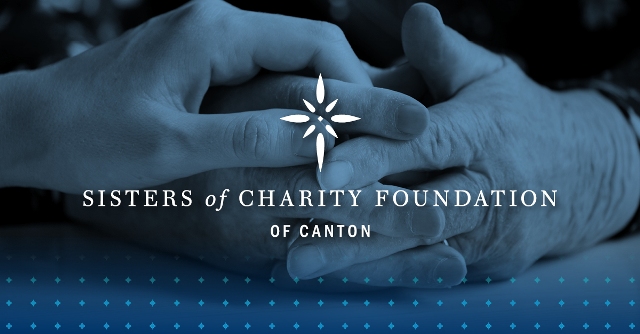Sisters of Charity Foundation of Canton making an impact on homelessness in Stark County

The Sisters of Charity Foundation of Canton, a ministry of the Sisters of Charity Health System, works to improve the quality of life of the poor and underserved so they can live to their fullest potential, which includes helping coordinate a coalition working to end homelessness in Stark County, Ohio. Jean Van Ness, senior program officer/special projects for the foundation, serves as the chair of this coalition, known as the Homeless Continuum of Care of Stark County.
The work of the Homeless Continuum of Care of Stark County was recently profiled by About magazine. The full text of the article appears below.
Homelessness – Picture of Need
The men and women stationed at the end of the interstate ramps holding a sign that says they are homeless and in need of food or money may be the only interaction most of us in Stark County have had with those who have no place to call home.
Homelessness is not as visible in Stark County as it is in major cities where panhandlers are as common as taxi cabs. Yet, homelessness is ever present locally, at times taxing local social service agencies and filling emergency and temporary shelters to capacity.
In January, homeless service providers and volunteers counted 460 people—including 286 persons with children—who didn’t have a stable place to live. They either were staying at an emergency shelter or in temporary housing or had been living on the street or in other places not fit for human habitation.
Jean C. Van Ness, senior program officer/special projects for the Sisters of Charity Foundation of Canton, said while the count, which is part of the federally required annual Point-in-Time surveys, is valuable for year-to-year comparisons, it only serves as a snapshot for a specific period of time. She said a truer gauge is the number of calls the county’s Homeless Hotline receives every month from people needing house help.
“The (actual) number of people who are homeless over the course of a year is six times higher than what the Point-in-Time count is,” said Van Ness, who chairs the 17-member board that leads the Homeless Continuum of Care of Stark County.
And that estimate doesn’t include the number of people who are at risk of homelessness—a figure that has more than doubled over the past seven years.
An end to homelessness?
The federal government has said it wants to end homelessness by 2022 and has set benchmarks for communities across the nation to meet along the way.
Members of the Homeless Continuum of Care of Stark County are more realistic.
“We’re never going to achieve zero,” Van Ness said. “We’re working toward a system that doesn’t have a big backlog and that can rapidly rehouse people who become homeless.”
The coalition, which includes more than 50 social service agencies, churches, schools, local governments and court systems, has been focusing its efforts and money in meeting the national goals of ending homelessness for veterans and finding permanent housing for those hardest to house, known as the chronically homeless.
They have spent thousands of dollars on developing additional affordable housing units and on providing more services to address the underlying reasons that led them to lose their homes. Agencies also have ramped up their efforts to provide what’s known as “rapid rehousing,” where families and individuals who are residing in an emergency or transitional shelter are given financial help to obtain housing until their situation stabilizes.
Stark County nearly reached its goal for veterans near the end of 2015. Only five veterans remained homeless at the time, and two of them were close to obtaining housing. But an unexpected surge of veterans needed housing occurred, causing the number of homeless veterans to rise to 16 when the Point-in-Time count was conducted in January. It’s unknown what caused the surge.
The number of chronically homeless has continued to decline in Stark County over the past two years, and homeless service providers are optimistic they can house all those who are chronically homeless by the end of 2017.
Jennifer Keaton, program manager for the Stark County Homeless Hotline, said the process will have its stops and starts because the chronically homeless need more help than simply a roof over their heads. She said they often aren’t used to living in four walls or sleeping on a bed, so they sometimes will leave the house to return to the more familiar streets.
“We go back and try again and eventually, they make progress,” Keaton said. “Even if they burn bridges, we don’t give up on them.”
At risk
One area of concern for local homeless service providers is the rising number of people who are at risk of homelessness.
According to the most recent Point-in-Time count, the number of Stark County residents at imminent risk of becoming homeless has doubled since 2009—from 246 in 2009 to 563 in 2016.
Van Ness said that while Stark County receives millions of dollars in government funding to help people who are homeless, few state and federal resources can be dedicated to fund homeless prevention.
She said the continuum agreed to create a task force to coordinate the efforts of the local agencies and churches that already provide people help to prevent evictions and foreclosures.
“We knew as a group that prevention was so hard to do well,” Van Ness said. “We started talking about how to do it better.”

- Sisters of Charity Health System
- News Releases
- St. Vincent Charity Health Campus
- Light of Hearts Villa
- Regina Health Center
- Sisters of Charity Foundation of Canton
- Sisters of Charity Foundation of Cleveland
- Sisters of Charity Foundation of South Carolina
- Building Healthy Communities
- Catholic Community Connection
- Early Childhood Resource Center
- Healthy Learners
- Joseph and Mary's Home
- South Carolina Center for Fathers and Families